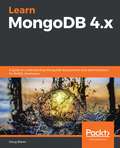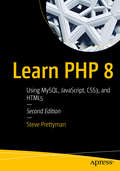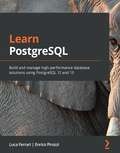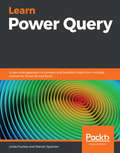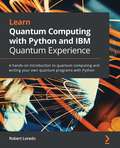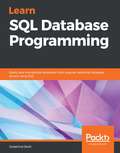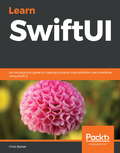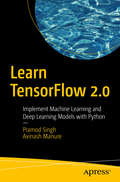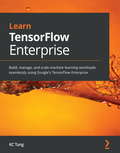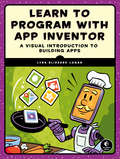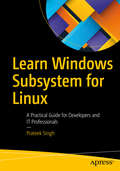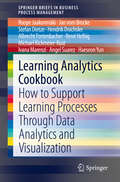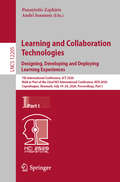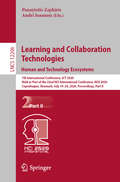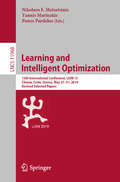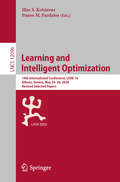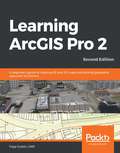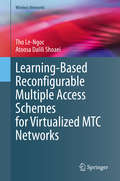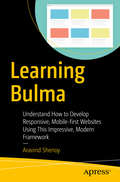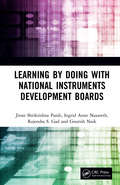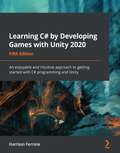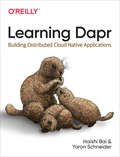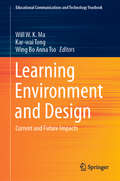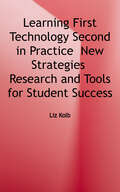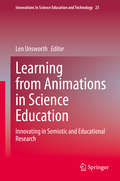- Table View
- List View
Learn MongoDB 4.x: A guide to understanding MongoDB development and administration for NoSQL developers
by Doug BiererDesign, administer, and deploy high-volume and fault-tolerant database applications using MongoDB 4.x Key Features Build a powerful and scalable MongoDB database using real industry data Understand the process of designing NoSQL schema with the latest release of MongoDB 4.x Explore the ins and outs of MongoDB, including queries, replication, sharding, and vital admin tasks Book Description When it comes to managing a high volume of unstructured and non-relational datasets, MongoDB is the defacto database management system (DBMS) for DBAs and data architects. This updated book includes the latest release and covers every feature in MongoDB 4.x, while helping you get hands-on with building a MongoDB database app. You'll get to grips with MongoDB 4.x concepts such as indexes, database design, data modeling, authentication, and aggregation. As you progress, you'll cover tasks such as performing routine operations when developing a dynamic database-driven website. Using examples, you'll learn how to work with queries and regular database operations. The book will not only guide you through design and implementation, but also help you monitor operations to achieve optimal performance and secure your MongoDB database systems. You'll also be introduced to advanced techniques such as aggregation, map-reduce, complex queries, and generating ad hoc financial reports on the fly. Later, the book shows you how to work with multiple collections as well as embedded arrays and documents, before finally exploring key topics such as replication, sharding, and security using practical examples. By the end of this book, you'll be well-versed with MongoDB 4.x and be able to perform development and administrative tasks associated with this NoSQL database. What you will learn Understand how to configure and install MongoDB 4.x Build a database-driven website using MongoDB as the backend Perform basic database operations and handle complex MongoDB queries Develop a successful MongoDB database design for large corporate customers with complex requirements Secure MongoDB database systems by establishing role-based access control with X.509 transport-level security Optimize reads and writes directed to a replica set or sharded cluster Perform essential MongoDB administration tasks Maintain database performance through monitoring Who this book is for This book is a MongoDB tutorial for DevOps engineers, database developers, database administrators, system administrators and those who are just getting started with NoSQL and looking to build document-oriented databases and gain real-world experience in managing databases using MongoDB. Basic knowledge of databases and Python is required to get started with this DBMS book.
Learn PHP 8: Using MySQL, JavaScript, CSS3, and HTML5
by Steve PrettymanWrite solid, secure, object-oriented code in the new PHP 8. In this book you will create a complete three-tier application using a natural process of building and testing modules within each tier. This practical approach teaches you about app development and introduces PHP features when they are actually needed rather than providing you with abstract theory and contrived examples. In Learn PHP 8, programming examples take advantage of the newest PHP features; you’ll follow a learn-by-doing approach, which provides you with complete coding examples. “Do It” exercises in each chapter provide the opportunity to make adjustments to the example code. The end-of-chapter programming exercises allow you to develop your own applications using the algorithms demonstrated in the chapter. Each tier is logically and physically separated using object-oriented and dependency injection techniques, thus allowing independent tiers that can be updated with little or no effect on the other tiers. In addition to teaching good programming practices through OOP, there is a strong emphasis on creating secure code. As each chapter is completed, you’ll have the opportunity to design and create an application reinforcing the concepts learned. What You Will Learn Program PHP 8 web applications Use interfaces, containers, and platforms Apply modular programming Manage data objects and use MySQL and other databases Work with multi-functional and secure user interfaces Handle logging exceptions and more Who This Book Is For Those new to web development, specifically PHP programming. Also, this book can be useful to those who have some PHP/web development experience who are new to PHP 8.
Learn PostgreSQL: Build and manage high-performance database solutions using PostgreSQL 12 and 13
by Enrico Pirozzi Luca FerrariA comprehensive guide to building, managing, and securing scalable and reliable database and data warehousing applications using Postgres 12 and 13 Key Features Set up your database cluster and monitor, secure, and fine-tune it for optimal performance Learn the fundamentals of database management and implement client- and server-side programming using SQL and PL/pgSQL Explore useful tips to develop efficient PostgreSQL database solutions from scratch Book Description PostgreSQL is one of the fastest-growing open source object-relational database management systems (DBMS) in the world. As well as being easy to use, it's scalable and highly efficient. In this book, you'll explore PostgreSQL 12 and 13 and learn how to build database solutions using it. Complete with hands-on tutorials, this guide will teach you how to achieve the right database design required for a reliable environment. You'll learn how to install and configure a PostgreSQL server and even manage users and connections. The book then progresses to key concepts of relational databases, before taking you through the Data Definition Language (DDL) and commonly used DDL commands. To build on your skills, you'll understand how to interact with the live cluster, create database objects, and use tools to connect to the live cluster. You'll then get to grips with creating tables, building indexes, and designing your database schema. Later, you'll explore the Data Manipulation Language (DML) and server-side programming capabilities of PostgreSQL using PL/pgSQL, before learning how to monitor, test, and troubleshoot your database application to ensure high-performance and reliability. By the end of this book, you'll be well-versed with the Postgres database and be able to set up your own PostgreSQL instance and use it to build robust solutions. What you will learn Understand how users and connections are managed by running a PostgreSQL instance Interact with transaction boundaries using server-side programming Identify bottlenecks to maintain your database efficiently Create and manage extensions to add new functionalities to your cluster Choose the best index type for each situation Use online tools to set up a memory configuration that will suit most databases Explore how Postgres can be used in multi-instance environments to provide high-availability, redundancy, and scalability Who this book is for This Postgres book is for anyone interested in learning about the PostgreSQL database from scratch. Anyone looking to build robust data warehousing applications and scale the database for high-availability and performance using the latest features of PostgreSQL will also find this book useful. Although prior knowledge of PostgreSQL is not required, familiarity with databases is expected.
Learn Power Query: A low-code approach to connect and transform data from multiple sources for Power BI and Excel
by Linda Foulkes Warren SparrowDiscover how you can combine data from various sources to create data models to suit your business requirements with the help of this clear and concise guide Key Features Understand how Power Query overcomes the shortcomings of Excel Power Pivot in handling complex data Create customized dashboards and multi-dimensional reports using Power Query and Power BI Learn the Power Query M language and write advanced queries using custom functions Book Description Power Query is a data connection technology that allows you to connect, combine, and refine data from multiple sources to meet your business analysis requirements. With this Power Query book, you'll be empowered to work with a variety of data sources to create interactive reports and dashboards using Excel and Power BI. You'll start by learning how to access Power Query across different versions of Excel and install the Power BI engine. After you've explored Power Pivot, you'll see why Excel users find it challenging to clean data in Power Pivot and learn how Power Query can help to tackle the problem. The book will show you how to transform data using the Query Editor and write functions in Power Query. A dedicated section will focus on functions such as IF, Index, and Modulo, and creating parameters to alter query paths in a table. You'll also work with dashboards, get to grips with multi-dimensional reporting, and create automated reports. As you advance, you'll cover the M formula language in Power Query, delve into the basic M syntax, and write the M query language with the help of examples such as loading all library functions offline in Excel and Power BI. Finally, the book will demonstrate the difference between M and DAX and show how results are produced in M. By the end of this book, you'll be ready to create impressive dashboards and multi-dimensional reports in Power Query and turn data into valuable insights. What you will learn Convert worksheet data into a table format ready for query output Create a dynamic connection between an Access database and Excel workbook Reshape tabular data by altering rows, columns, and tables using various Power Query tools Create new columns automatically from filenames and sheet tabs, along with multiple Excel data files Streamline and automate reports from multiple sources Explore different customization options to get the most out of your dashboards Understand the difference between the DAX language and Power Query's M language Who this book is for This Power Query book is for business analysts, data analysts, BI professionals, and Excel users looking to take their skills to the next level by learning how to collect, combine, and transform data into insights using Power Query. Working knowledge of Excel and experience in constructing and troubleshooting Excel formulas and functions is expected.
Learn Quantum Computing with Python and IBM Quantum Experience: A hands-on introduction to quantum computing and writing your own quantum programs with Python
by Robert LoredoA step-by-step guide to learning the implementation and associated methodologies in quantum computing with the help of the IBM Quantum Experience, Qiskit, and Python that will have you up and running and productive in no time Key Features Determine the difference between classical computers and quantum computers Understand the quantum computational principles such as superposition and entanglement and how they are leveraged on IBM Quantum Experience systems Run your own quantum experiments and applications by integrating with Qiskit Book Description IBM Quantum Experience is a platform that enables developers to learn the basics of quantum computing by allowing them to run experiments on a quantum computing simulator and a real quantum computer. This book will explain the basic principles of quantum mechanics, the principles involved in quantum computing, and the implementation of quantum algorithms and experiments on IBM's quantum processors. You will start working with simple programs that illustrate quantum computing principles and slowly work your way up to more complex programs and algorithms that leverage quantum computing. As you build on your knowledge, you'll understand the functionality of IBM Quantum Experience and the various resources it offers. Furthermore, you'll not only learn the differences between the various quantum computers but also the various simulators available. Later, you'll explore the basics of quantum computing, quantum volume, and a few basic algorithms, all while optimally using the resources available on IBM Quantum Experience. By the end of this book, you'll learn how to build quantum programs on your own and have gained practical quantum computing skills that you can apply to your business. What you will learn Explore quantum computational principles such as superposition and quantum entanglement Become familiar with the contents and layout of the IBM Quantum Experience Understand quantum gates and how they operate on qubits Discover the quantum information science kit and its elements such as Terra and Aer Get to grips with quantum algorithms such as Bell State, Deutsch-Jozsa, Grover's algorithm, and Shor's algorithm How to create and visualize a quantum circuit Who this book is for This book is for Python developers who are looking to learn quantum computing and put their knowledge to use in practical situations with the help of IBM Quantum Experience. Some background in computer science and high-school-level physics and math is required.
Learn SQL Database Programming: Query and manipulate databases from popular relational database servers using SQL
by Josephine BushLearn everything you need to know to build efficient SQL queries using this easy-to-follow beginner's guide Key Features Explore all SQL statements in depth using a variety of examples Get to grips with database querying, data aggregate, manipulation, and much more Understand how to explore and process data of varying complexity to tell a story Book Description SQL is a powerful querying language that's used to store, manipulate, and retrieve data, and it is one of the most popular languages used by developers to query and analyze data efficiently. If you're looking for a comprehensive introduction to SQL, Learn SQL Database Programming will help you to get up to speed with using SQL to streamline your work in no time. Starting with an overview of relational database management systems, this book will show you how to set up and use MySQL Workbench and design a database using practical examples. You'll also discover how to query and manipulate data with SQL programming using MySQL Workbench. As you advance, you'll create a database, query single and multiple tables, and modify data using SQL querying. This SQL book covers advanced SQL techniques, including aggregate functions, flow control statements, error handling, and subqueries, and helps you process your data to present your findings. Finally, you'll implement best practices for writing SQL and designing indexes and tables. By the end of this SQL programming book, you'll have gained the confidence to use SQL queries to retrieve and manipulate data. What you will learn Install, configure, and use MySQL Workbench to restore a database Explore different data types such as string, numeric, and date and time Query a single table using the basic SQL SELECT statement and the FROM, WHERE, and ORDER BY clauses Query multiple tables by understanding various types of table relationships Modify data in tables using the INSERT, UPDATE, and DELETE statements Use aggregate functions to group and summarize data Detect bad data, duplicates, and irrelevant values while processing data Who this book is for This book is for business analysts, SQL developers, database administrators, and students learning SQL. If you want to learn how to query and manipulate SQL data for database administration tasks or simply extract and organize relevant data for analysis, you'll find this book useful. No prior SQL experience is required.
Learn SwiftUI: An introductory guide to creating intuitive cross-platform user interfaces using Swift 5
by Chris BarkerGet to grips with Apple's new SwiftUI framework for creating robust UIs for iOS and iPadOS using Swift programming Key Features Use SwiftUI for building dynamic apps for Apple devices from scratch Understand declarative syntax in cross-platform development and how states work within SwiftUI Learn to develop watchOS apps by reusing SwiftUI code Book Description SwiftUI is the new and powerful interface toolkit that lets you design and build iOS, iPadOS, and macOS apps using declarative syntax. It is a powerful way to develop the UI elements of applications, which would normally be tightly coupled to application logic. Learn SwiftUI will get you up to speed with the framework and cross-device UI development in no time. Complete with detailed explanations and practical examples, this easy-to-follow guide will teach you the fundamentals of the SwiftUI toolkit. You'll learn how to build a powerful iOS and iPadOS application that can be reused for deployment on watchOS. As you progress, you'll delve into UI and unit testing in iOS apps, along with learning how to test your SwiftUI code for multiple devices. The book will also show you how to integrate SwiftUI features such as data binding and network requests into your current application logic. By the end of this book, you will have learned how to build a cross-device application using the SwiftUI framework and Swift programming. What you will learn Explore the fundamentals of SwiftUI and compare it with existing UI frameworks Write SwiftUI syntax and understand what should and shouldn't be included in SwiftUI's layer Add text and images to a SwiftUI view and decorate them using SwiftUI's modifiers Create basic forms, and use camera and photo library functions to add images to them Understand the core concepts of Maps in iOS apps and add a MapView in SwiftUI Design extensions within your existing apps to run them on watchOS Handle networking calls in SwiftUI to retrieve data from external sources Who this book is for This SwiftUI book helps any mobile app developer looking to understand the fundamentals of the new SwiftUI framework along with the benefits of cross-device development. A solid understanding of iOS and macOS app development, along with some knowledge of the Swift programming language, will be beneficial. Basic programming knowledge is essential to grasp the concepts covered in the book effectively.
Learn TensorFlow 2.0: Implement Machine Learning and Deep Learning Models with Python
by Pramod Singh Avinash ManureLearn how to use TensorFlow 2.0 to build machine learning and deep learning models with complete examples. The book begins with introducing TensorFlow 2.0 framework and the major changes from its last release. Next, it focuses on building Supervised Machine Learning models using TensorFlow 2.0. It also demonstrates how to build models using customer estimators. Further, it explains how to use TensorFlow 2.0 API to build machine learning and deep learning models for image classification using the standard as well as custom parameters. You'll review sequence predictions, saving, serving, deploying, and standardized datasets, and then deploy these models to production. All the code presented in the book will be available in the form of executable scripts at Github which allows you to try out the examples and extend them in interesting ways.What You'll LearnReview the new features of TensorFlow 2.0Use TensorFlow 2.0 to build machine learning and deep learning models Perform sequence predictions using TensorFlow 2.0Deploy TensorFlow 2.0 models with practical examplesWho This Book Is ForData scientists, machine and deep learning engineers.
Learn TensorFlow Enterprise: Build, manage, and scale machine learning workloads seamlessly using Google's TensorFlow Enterprise
by KC TungThis book is for data scientists, machine learning developers or engineers, and cloud practitioners who want to learn and implement various services and features offered by TensorFlow Enterprise from scratch. Basic knowledge of the machine learning development process will be useful.
Learn to Program with App Inventor: A Visual Introduction to Building Apps
by Lyra LoganLearn to build mobile apps for Android devices with MIT App Inventor, a visual drag-and-drop programming language like Scratch.You've swiped and tapped your way through countless apps, but have you ever created one? Now you can, thanks to Learn to Program with App Inventor. In less than an hour, you'll be able to build and run your first app!App Inventor is a free software for making Android apps. All you need is a PC with an Internet connection to build your app, and a mobile phone for testing. You'll use a simple drag-and-drop interface, which minimizes errors and avoids too much typing. A certified App Inventor Master Trainer, Logan breaks down each project into logical steps, lists the components you'll need, and then shows you how to create screen designs, control program flow with conditionals and loops, and store data in variables and lists. Once you've tested the app on your phone, you can test what you learned with challenges at the end of each chapter.You'll build cool apps like: * Hi, World!: Use your voice to send a text message * Practice Makes Perfect: Rehearse a speech or dance routine with this video recording app * Fruit Loot: Catch randomly failing fruit in this exciting game * Beat the Bus: Track a friend's journey using location services and maps * Virtual Shades: Take a selfie, then try on some virtual sunglassesJoin the 6 million people who have tried App Inventor, and make the journey from app user to app inventor.
Learn Windows Subsystem for Linux: A Practical Guide for Developers and IT Professionals
by Prateek SinghBecome productive with seamless interoperability between Windows and the Linux subsystem, and understand the problems that Windows Subsystem for Linux (WSL) solves. Microsoft has pushed the boundaries of open source research with WSL and you don't want to miss this ride. You will learn keywords, definitions, new features, setup, and use cases around WSL, starting from downloading to setup to interoperability between Windows and Linux subsystems. You will understand the architecture of WSL and all the new features in WSL 2. This book includes wonderful use cases, including a dedicated chapter to how to start programming and web development on WSL, and the ability to use containerization solutions like Docker and Kubernetes. WSL is a great solution to work natively in a Linux environment from your Windows 10 machines. Modern applications demand integration of cross-platform tools, services and technologies. WSL makes life for developers and system administrators easy because it allows Linux applications to run on Windows without worrying about installing a Linux distribution on a traditional Virtual Machine. It is remarkable product with powerful functionality – get started with it using this book today. What You'll LearnReview the workings and internals of WSL and WSL2 Run Linux-based applications natively on WindowsEstablish your development environment in WSLBuild mixed experiences (Windows-Linux)Set up and manage WSL and supported distribution packages. Who This Book Is For Programmers, web developers and system administrators working on Windows and Linux environments who want to bridge the gap between operating systems by running a Linux as a subsystem on Windows to boost their overall productivity, performance and delivery.
Learning Analytics Cookbook: How to Support Learning Processes Through Data Analytics and Visualization (SpringerBriefs in Business Process Management)
by Roope Jaakonmäki Stefan Dietze Hendrik Drachsler Albrecht Fortenbacher René Helbig Michael Kickmeier-Rust Ivana Marenzi Angel Suarez Haeseon Yun Jan vom BrockeThis book offers an introduction and hands-on examples that demonstrate how Learning Analytics (LA) can be used to enhance digital learning, teaching and training at various levels. While the majority of existing literature on the subject focuses on its application at large corporations, this book develops and showcases approaches that bring LA closer to smaller organizations, and to educational institutions that lack sufficient resources to implement a full-fledged LA infrastructure. In closing, the book introduces a set of software tools for data analytics and visualization, and explains how they can be employed in several LA scenarios.
Learning and Collaboration Technologies. Designing, Developing and Deploying Learning Experiences: 7th International Conference, LCT 2020, Held as Part of the 22nd HCI International Conference, HCII 2020, Copenhagen, Denmark, July 19–24, 2020, Proceedings, Part I (Lecture Notes in Computer Science #12205)
by Panayiotis Zaphiris Andri IoannouThis two-volume set LNCS 12205 and LNCS 12206 constitutes the proceedings of the 7th International Conference on Learning and Collaboration Technologies, LCT 2020, held as part of the 22nd International Conference, HCI International 2020, which took place in Copenhagen, Denmark, in July 2020.The total of 1439 papers and 238 posters included in the 37 HCII 2020 proceedings volumes was carefully reviewed and selected from 6326 submissions.The papers in this volume are organized in the following topical sections: designing and evaluating learning experiences; learning analytics, dashboards and learners models; language learning and teaching; and technology in education: policies and practice. As a result of the Danish Government's announcement, dated April 21, 2020, to ban all large events (above 500 participants) until September 1, 2020, the HCII 2020 conference was held virtually.
Learning and Collaboration Technologies. Human and Technology Ecosystems: 7th International Conference, LCT 2020, Held as Part of the 22nd HCI International Conference, HCII 2020, Copenhagen, Denmark, July 19–24, 2020, Proceedings, Part II (Lecture Notes in Computer Science #12206)
by Panayiotis Zaphiris Andri IoannouThis two-volume set LNCS 12205 and LNCS 12206 constitutes the proceedings of the 7th International Conference on Learning and Collaboration Technologies, LCT 2020, held as part of the 22nd International Conference, HCI International 2020, which took place in Copenhagen, Denmark, in July 2020.The total of 1439 papers and 238 posters included in the 37 HCII 2020 proceedings volumes was carefully reviewed and selected from 6326 submissions.The papers in this volume are organized in the following topical sections: communication and conversation in learning; cognition, emotions and learning; games and gamification in learning; VR, robot and IoT in learning; and collaboration technology and collaborative learning. As a result of the Danish Government's announcement, dated April 21, 2020, to ban all large events (above 500 participants) until September 1, 2020, the HCII 2020 conference was held virtually.
Learning and Intelligent Optimization: 13th International Conference, LION 13, Chania, Crete, Greece, May 27–31, 2019, Revised Selected Papers (Lecture Notes in Computer Science #11968)
by Panos Pardalos Nikolaos F. Matsatsinis Yannis MarinakisThis book constitutes the thoroughly refereed pChania, Crete, Greece, in May 2019. The 38 full papers presented have been carefully reviewed and selected from 52 submissions. The papers focus on advancedresearch developments in such interconnected fields as mathematical programming, global optimization, machine learning, and artificial intelligence and describe advanced ideas, technologies, methods, and applications in optimization and machine learning.
Learning and Intelligent Optimization: 14th International Conference, LION 14, Athens, Greece, May 24–28, 2020, Revised Selected Papers (Lecture Notes in Computer Science #12096)
by Ilias S. Kotsireas Panos M. PardalosThis book constitutes the refereed post-conference proceedings on Learning and Intelligent Optimization, LION 14, held in Athens, Greece, in May 2020. The 37 full papers presented together with one invited paper have been carefully reviewed and selected from 75 submissions. LION deals with designing and engineering ways of "learning" about the performance of different techniques, and ways of using past experience about the algorithm behavior to improve performance in the future. Intelligent learning schemes for mining the knowledge obtained online or offline can improve the algorithm design process and simplify the applications of high-performance optimization methods. Combinations of different algorithms can further improve the robustness and performance of the individual components. Due to the COVID-19 pandemic, LION 14 was not held as a physical meeting.
Learning ArcGIS Pro 2: A beginner's guide to creating 2D and 3D maps and editing geospatial data with ArcGIS Pro, 2nd Edition
by Tripp CorbinCreate 2D maps and 3D scenes, analyze GIS data, and share your results with the GIS community using the latest ArcGIS Pro 2 features Key Features Get up to speed with the new ribbon-based user interface, projects, models, and common workflows in ArcGIS Pro 2 Learn how to visualize, maintain, and analyze GIS data Automate analysis and processes with ModelBuilder and Python scripts Book Description Armed with powerful tools to visualize, maintain, and analyze data, ArcGIS Pro 2 is Esri's newest desktop geographic information system (GIS) application that uses the modern ribbon interface and a 64-bit processor to make using GIS faster and more efficient. This second edition of Learning ArcGIS Pro will show you how you can use this powerful desktop GIS application to create maps, perform spatial analysis, and maintain data. The book begins by showing you how to install ArcGIS and listing the software and hardware prerequisites. You'll then understand the concept of named user licensing and learn how to navigate the new ribbon interface to leverage the power of ArcGIS Pro for managing geospatial data. Once you've got to grips with the new interface, you'll build your first GIS project and understand how to use the different project resources available. The book shows you how to create 2D and 3D maps by adding layers and setting and managing the symbology and labeling. You'll also discover how to use the analysis tool to visualize geospatial data. In later chapters, you'll be introduced to Arcade, the new lightweight expression language for ArcGIS, and then advance to creating complex labels using Arcade expressions. Finally, you'll use Python scripts to automate and standardize tasks and models in ArcGIS Pro. By the end of this ArcGIS Pro book, you'll have developed the core skills needed for using ArcGIS Pro 2.x competently. What you will learn Navigate the user interface to create maps, perform analysis, and manage data Display data based on discrete attribute values or range of values Label features on a GIS map based on one or more attributes using Arcade Create map books using the map series functionality Share ArcGIS Pro maps, projects, and data with other GIS community members Explore the most used geoprocessing tools for performing spatial analysis Create Tasks based on common workflows to standardize processes Automate processes using ModelBuilder and Python scripts Who this book is for If you want to learn ArcGIS Pro to create maps and, edit and analyze geospatial data, this ArcGIS book is for you. No knowledge of GIS fundamentals or experience with any GIS tool or ArcGIS software suite is required. Basic Windows skills, such as navigating and file management, are all you need.
Learning-Based Reconfigurable Multiple Access Schemes for Virtualized MTC Networks (Wireless Networks)
by Tho Le-Ngoc Atoosa Dalili ShoaeiThis book assists readers with understanding the key aspects, problems and solutions related to the design of proper Multiple Access Schemes for MTC (Machine-Type Communications) and IoT applications in 5G-and-beyond wireless networks. An overview of MTC applications and their traffic features are also provided. In addition, it presents a comprehensive review of MTC access schemes including orthogonal multiple access schemes (OMA), non-orthogonal multiple access schemes (NOMA), massive MIMO-based schemes and fast uplink grant approaches. It also proposes efficient and reconfigurable access schemes deploying machine learning and optimization techniques to address the main requirements of MTC networks. This book discusses potential research directions to further enhance the performance of MTC access schemes.Machine-type communications are expected to account for the dominant share of the traffic in future wireless networks. While in traditional wireless networks, designed for human-type communications, the focus is on support of large packet sizes in downlink, machine-type communication systems deal with heavy uplink traffic. This is due to the nature of the tasks performed by machine-type communication devices, which is mainly reporting measured data or a detected event. Furthermore, in these networks, using the virtualization framework, the network infrastructure can be shared between different applications for which providing isolation is of high importance. To support these unique characteristics of machine-type communications, proper access schemes need to be developed, which is the focus of this book.This book benefits advanced-level students studying computer science and electrical engineering as a secondary textbook and researchers working in this field. Engineers and practitioners interested in the challenges and practical solutions of integrating MTC in the cloud radio access network of 5G-and-beyond cellular systems will want to purchase this book as well.
Learning Bulma: Understand How to Develop Responsive, Mobile-first Websites Using This Impressive, Modern Framework
by Aravind ShenoyLearn to use Bulma in your HTML file by applying easy-to-understand practical examples to create responsive and mobile-first websites.Featuring a step-by-step approach, this book encourages you to modify its code examples and review the changes produced in the output, to thereby reveal the subtle nuances of this awesome utility. Bulma is an impressive, modern framework utility that allows the easy construction of web pages thanks to the highly flexible Flex-box grid styles and simple syntax. You'll see how to use Bulma’s intuitive CSS capabilities to create interactive websites that support responsive design by dynamically adjusting the layout resulting in an optimal viewing experience. You'll then delve into typical modifiers, columns, Flex-box grid styles, forms, elements, utilities, CSS components, and more. By the end of this book, you will be familiar with the inner workings of Bulma at an intermediate level and be equipped to aptly leverage Bulma’s utilities to streamline your web designing experience. What You'll LearnGet started quickly with Bulma Use the grid system, layout, content, and modifiersLeverage Bulma’s built-in CSS utilitiesStreamline the web design experience with Bulma’s flexible attributesEffectively take a mobile-first approachWho This Book Is ForBeginners who have a basic understanding of HTML, CSS and JavaScript.
Learning by Doing with National Instruments Development Boards
by Jivan Shrikrishna Parab Ingrid Anne Nazareth Rajendra S. Gad Gourish NaikLearning by Doing with National Instruments Development Boards starts with a brief introduction to LabVIEW programming, which is required to explore the National Instrument platform, an introduction that includes detailed installation and licensing setup. Further, it gives the features and configuration setup of NI SPEEDY-33, NI ELVIS and myRIO boards. The focus of the book is on worked-out case studies for students working in different areas of electronics such as basic digital design, biomedical instrumentation, sensors and measurement. Data acquisition using SPEEDY-33, NI –ELVIS and myRIO kits is also odiscussed. The book also examines the myRIO platform.
Learning C# by Developing Games with Unity 2020 - Fifth Edition: An Enjoyable And Intuitive Approach To Getting Started With C# Programming And Unity
by Harrison FerroneIf you’re a developer, programmer, or anyone who wants to get started with C# programming in a fun and engaging manner, this book is for you. It’ll show you how to use the C# language and Unity to create games and scripts. Prior experience in programming or Unity is not required.
Learning Dapr
by Haishi Bai Yaron SchneiderGet the authoritative guide to Dapr, the distributed application runtime that works with new and existing programming languages alike. Written by the model’s creators, this introduction shows you how Dapr not only unifies stateless, stateful, and actor programming models but also runs everywhere—in the cloud or on the edge.Authors Haishi Bai and Yaron Schneider, both with Microsoft’s Azure CTO team, explain that, with Dapr, you don’t need to include any SDKs or libraries in your user code. Instead, you automatically get flexible binding, state management, the actor pattern, pub-sub, reliable messaging, and many more features. This book shows developers, architects, CIOs, students, and computing enthusiasts how to get started with Dapr.Learn the new programming model for cloud native applicationsWrite high-performance distributed applications without drilling into technical detailsUse Dapr with any language or framework to write microservices easilyLearn how Dapr provides consistency and portability through open APIs and extensible, community-driven componentsExplore how Dapr handles state, resource bindings, and pub-sub messaging to enable resilient event-driven architectures that scaleIntegrate cloud applications with various SaaS offerings, such as machine learning
Learning Environment and Design: Current and Future Impacts (Educational Communications and Technology Yearbook)
by Will W. K. Ma Kar-Wai Tong Wing Bo Anna TsoThis special edition of the Educational Communications and Technology Yearbook Series bears a title of “Learning Environment and Design: Current and Future Impact”. It provides a timely forum to share theoretical and practical insights in both the local and international contexts in response to the fact that new media and technologies have infiltrated and shaped the learning environments from mere physical spaces into multifaceted possibilities, impacting the ways individuals teach and learn. Designs of learning environments to harness technologies appropriately to engage learners better, as well as the roles of learners and educators play in this changing learning environment, are examples of important global issues in the discourse of the contemporary educational developments. Having gathered a diverse collection of research papers written by scholars and practitioners in the fields of education, communication and humanities across Asia, Australasia, Europe and the United States, this book gives readers a cross-cultural background on the developments of technological designs and educational practices, investigating areas in redefining of quality education; online learning and blended learning; new media in education; gamification, AI, and innovative learning technologies. Aimed to catalyze knowledge exchanges and provide fresh views on interdisciplinary research, the book sheds light on how emerging technologies can be adapted in the fields of education and communication, so as to facilitate the current and future designs of learning environments to improve learners’ performances.
Learning First, Technology Second in Practice: New Strategies, Research and Tools for Student Success
by Liz KolbBuilding on the bestselling Learning First, Technology Second, this book helps teachers choose technology tools and instructional strategies based on an understanding of how students learn. <p><p>After observing teachers and students interact with technology over many years, Liz Kolb began to wonder: While students' attention levels are high when they use digital devices, how can we move them to an equally high level of commitment to their learning tasks? Her extensive research into this question led to the development of the Triple E Framework, in which the learning goal—not the tool—is the most important element of a given lesson. <p><p>With this understanding, this book extends the ideas from Learning First, Technology Second, offering: <p><p>- An overview of the popular and highly regarded Triple E Framework. <p>- A compelling myth vs. reality format through which to apply the research and strategies tied to the Triple E Framework. <p>- A step-by-step process for instructional designers and tech coaches to use the framework with classroom teachers for better lesson design. <p>- Twelve authentic lessons designed by K-12 teachers to meet all three elements of the Triple E Framework, with suggestions on how to improve lessons with technology. <p>- Examples of how two schools have systematically integrated the framework across their district. <p><p>For Learning First, Technology Second readers, this book builds on their knowledge, providing new research, scenarios, cases and ideas for using technology in education. For readers new to the framework, this book provides all of the essential research and tools mentioned above, along with an overview of the framework, so they can apply what they learn without missing a beat.
Learning from Animations in Science Education: Innovating in Semiotic and Educational Research (Innovations in Science Education and Technology #25)
by Len UnsworthThis book examines educational semiotics and the representation of knowledge in school science. It discusses the strategic integration of animation in science education. It explores how learning through the creation of science animations takes place, as well as how animation can be used in assessing student’s science learning. Science education animations are ubiquitous in a variety of different online sites, including perhaps the most popularly accessed YouTube site, and are also routinely included as digital augmentations to science textbooks. They are popular with students and teachers and are a prominent feature of contemporary science teaching. The proliferation of various kinds of science animations and the ready accessibility of sophisticated resources for creating them have emphasized the importance of research into various areas: the nature of the semiotic construction of knowledge in the animation design, the development of critical interpretation of available animations, the strategic selection and use of animations to optimize student learning, student creation of science animations, and using animation in assessing student science learning. This book brings together new developments in these research agendas to further multidisciplinary perspectives on research to enhance the design and pedagogic use of animation in school science education. Chapter 1 is available open access under a Creative Commons Attribution 4.0 International License via link.springer.com.
